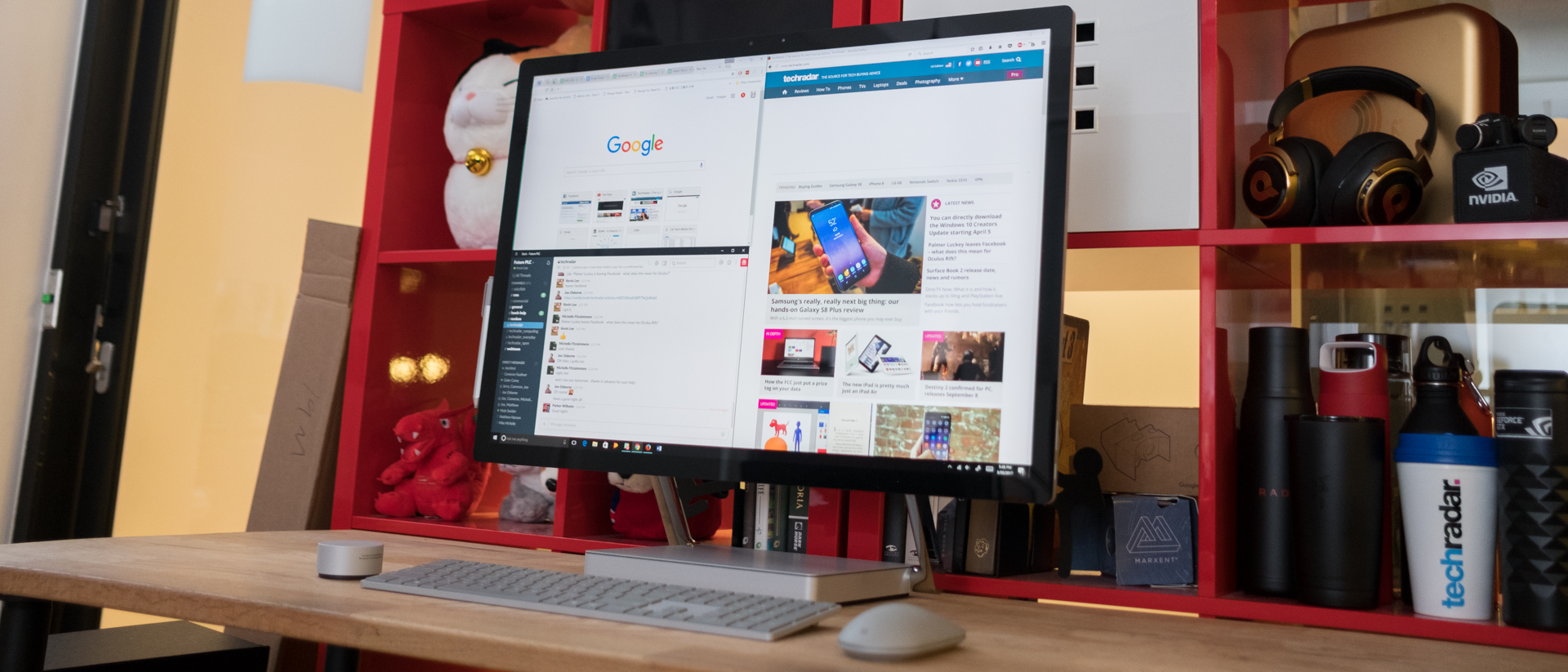TechRadar Verdict
The Surface Studio is a most impressive desktop that has already shaken up the all-in-one PC landscape. However, its exorbitant price makes it an extravagant investment for everyone but artists and illustrators.
Pros
- +
Seamlessly transitions between modes
- +
The best and biggest digital drawing board
- +
Impeccable build quality
Cons
- -
All rearward ports
- -
Pricey proposition for most
Why you can trust TechRadar
Did you know there’s a new Surface Studio? Check out our Surface Studio 2 review.
The Surface Studio comes with a hefty price tag. As such an expensive device, most people will look elsewhere for their computing needs. However, this all-in-one computer has become a go-to device for professionals and artists. It’s also compelled those who resisted getting an all-in-one with a full version of Windows 10 Pro to jump onboard.
By letting users utilize custom scripts when updating the OS, the Surface Studio is courting IT professionals and enterprise users. While that won’t be of interest to most users, it just goes to show how capable this all-in-one really is. The Surface Studio combines the versatility of the best 2-in-1 laptops with the horsepower of a conventional PC.
Microsoft’s Surface sales keep getting stronger with a 21% leap
Microsoft’s next Surface Pen could be a smart stylus usable across all devices
The Surface Studio is not the first touchscreen desktop that have come our way. But due to its Zero Gravity Hinge, this device can change into a virtual drafting table with ease. The Surface Dial really adds to why this desktop so special and makes the Surface Studio unique among all-in-ones.
The Surface Studio is not for everyone. Even with the Surface Studio 2 out, this is still quite expensive and, for those who don’t need the Studio’s unique qualities, other options will give you more computing power for less money. For those who benefit from what makes the Surface Studio so special, the device might be well worth the cost. Read on to see if the flexibility of the Studio and all its excellent accessories are for you.
Here is the Microsoft Surface Studio configuration sent to TechRadar for review:
CPU: 2.7GHz Intel Core i7-6820HQ (quad-core, 8MB cache, up to 3.6GHz)
Graphics: Nvidia GeForce GTX 980M (4GB GDDR5 VRAM)
RAM: 32GB DDR4
Screen: 28.125-inch, (4,500 x 3,000) PixelSense Display
Storage: 2TB, 5,400 rpm Rapid Hybrid Drive Storage (128GB SSD)
Ports: 4 x USB 3.0, SD card reader, mini DisplayPort, headset jack
Connectivity: 802.11ac Wi-Fi, Bluetooth 4.0
Operating system: Windows 10 64-bit
Camera: 5MP Windows Hello camera
Weight: 21.07 pounds (9.56kg)
Size (display): 25.09x 17.27 x 0.44 inches (63.7 x 43.9 x 1.14cm W x D x H)
Size (base): 9.84 x 8.66 x 1.26 inches (25 x 22 x 3.22cm W x D x H)
Pricing and availability
Traditionally, Surface devices represent a premium market, but the Surface Studio takes that to the next level. The original Surface Book started out at an astronomical $2,999 (£2,999, AU$4,699) with an Intel Core i5 CPU with 8GB of RAM, a 1TB HDD (with an integrated 64GB SSD) and an Nvidia GeForce GTX 965 GPU. All versions come with a 28-inch (4,500 x 3,000) display.
The Surface Studio ranges from that to the whopping $4,199 (£4,249, AU$6,599) configuration that we reviewed here.
The ‘cheapest’ unit is packing with a 6th-generation Intel Core i5 processor, 8GB of RAM, a 2GB Nvidia GeForce GTX 965M GPU and 1TB of storage.
Meanwhile, if you want to max out the Surface Studio, you’ll get an Intel Core i7 processor, 32GB of RAM and a 4GB GTX 980M eGPU.
A total of $4,199 (£4,249, AU$6,599) is a steep price, particularly when you can pick up an HP Z1 G3 for only $1,359 (about £971, AU$1,723) with a business-class Intel Xeon E3-1270 CPU, Nvidia Quadro M2000M graphics and a 3,840 x 2,160 4K screen to top it all off. Plus, unlike the Surface Studio before it, HP’s workstation all-in-one is easily upgradeable and future-proof, thanks to the accessibility to its internals.
The Surface Studio reviewed here is, without a doubt, a luxurious purchase. Even if you were to max out the Dell XPS 27 AIO, it wouldn’t even come close at $3,299 or £2,999 (about AU$4,320). Similarly, the HP Envy AIO 27 maxes out at only $1,799 (about £1,346, AU$2,363).
You can pick up the Surface Studio 2, with updated internals, but you’re looking at an even higher price tag, with the base model will set you back $3,499 (AU$5,499, about £2,750).
Either way, because the Surface Studio 2 has been on the market for a while now and the original has been officially discontinued, so you’ll have problems finding a Surface Studio these days – new or otherwise.
However, this doesn’t mean that wouldn’t be able to. There should be plenty of refurbished Surface Studios out there, especially since more and more people are upgrading to the new model.
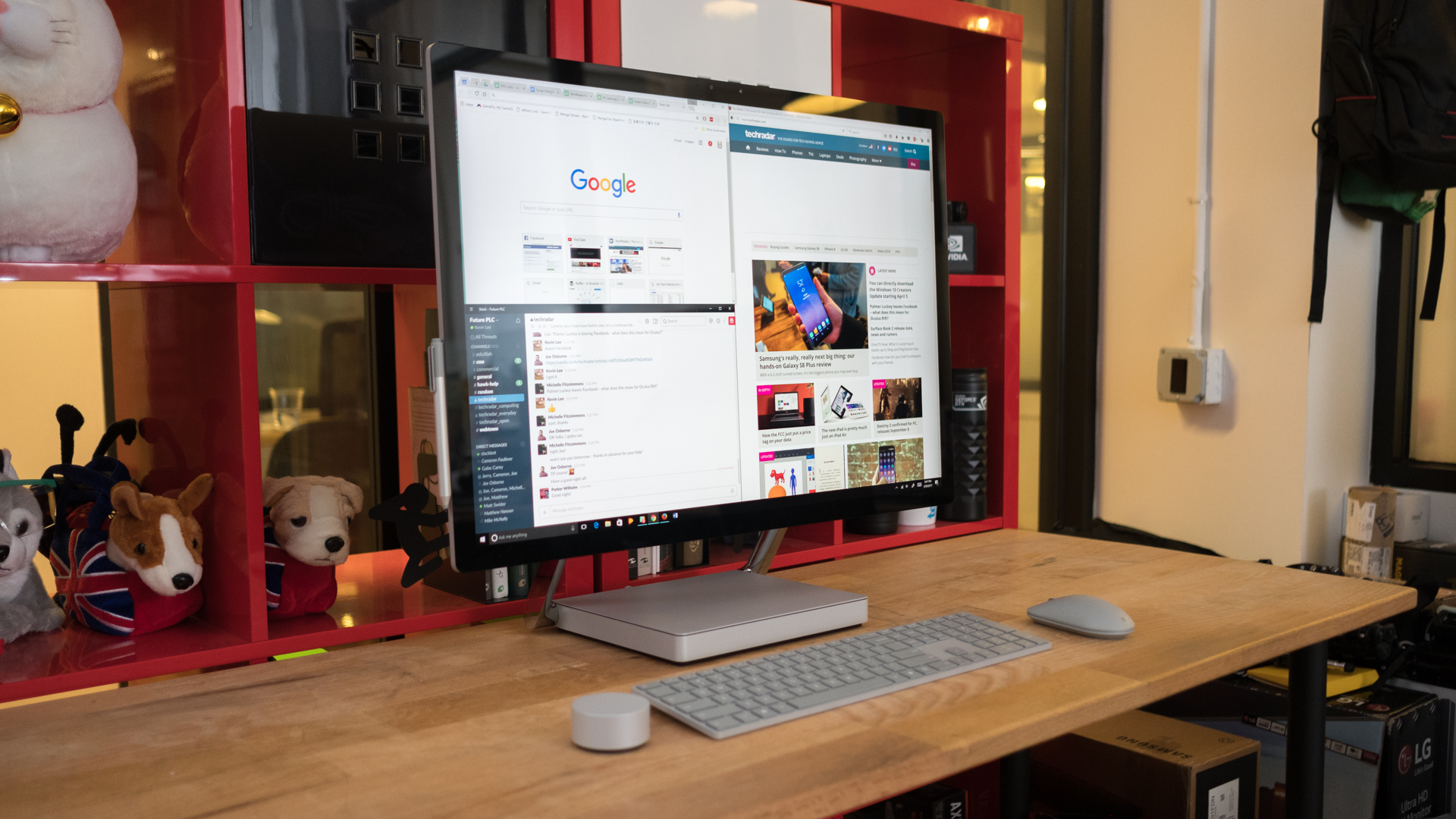
Design
The moment we pulled the Surface Studio out of its box, we knew it was love at first sight.
There isn’t any shortage of staggering desktops on the market, from Apple’s ever-thinning iMacs to the six-speaker sound on Dell’s XPS 27 AIO. Still, nothing comes close to the elegance and simplicity of the Surface Studio, except perhaps the Surface Studio 2.
By moving all the components to the base, the display is just a touchscreen with remarkably thin bezels. Without that rear bulk, the profile of the screen is just 12.5mm, making it slimmer than the best monitors on the market.
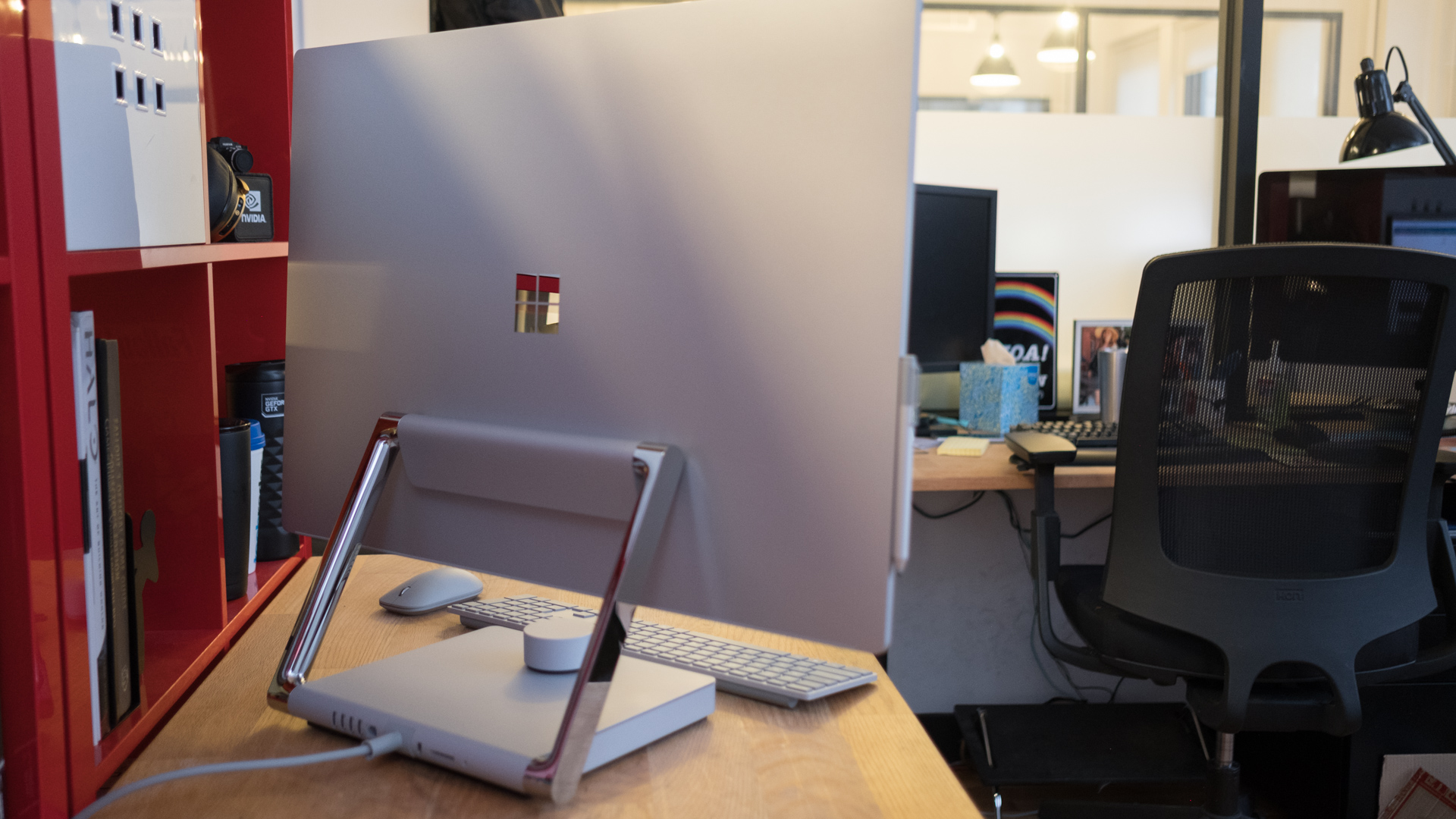
There’s also no fat chin underneath the screen to flaunt a Windows logo, which is actually refreshing to see. The only branding you’ll find is a mirrored logo on the back.
The Surface Studio is a modern and clean desktop designed with straight edges and a simple gray on chrome aesthetic. The base of the desktop takes this a step farther by simply being an almost featureless, ashen box. The only obvious element is a subtle line that wraps around the perimeter of the Studio’s foundation. This provides cooling for the mobile computing parts sitting inside.
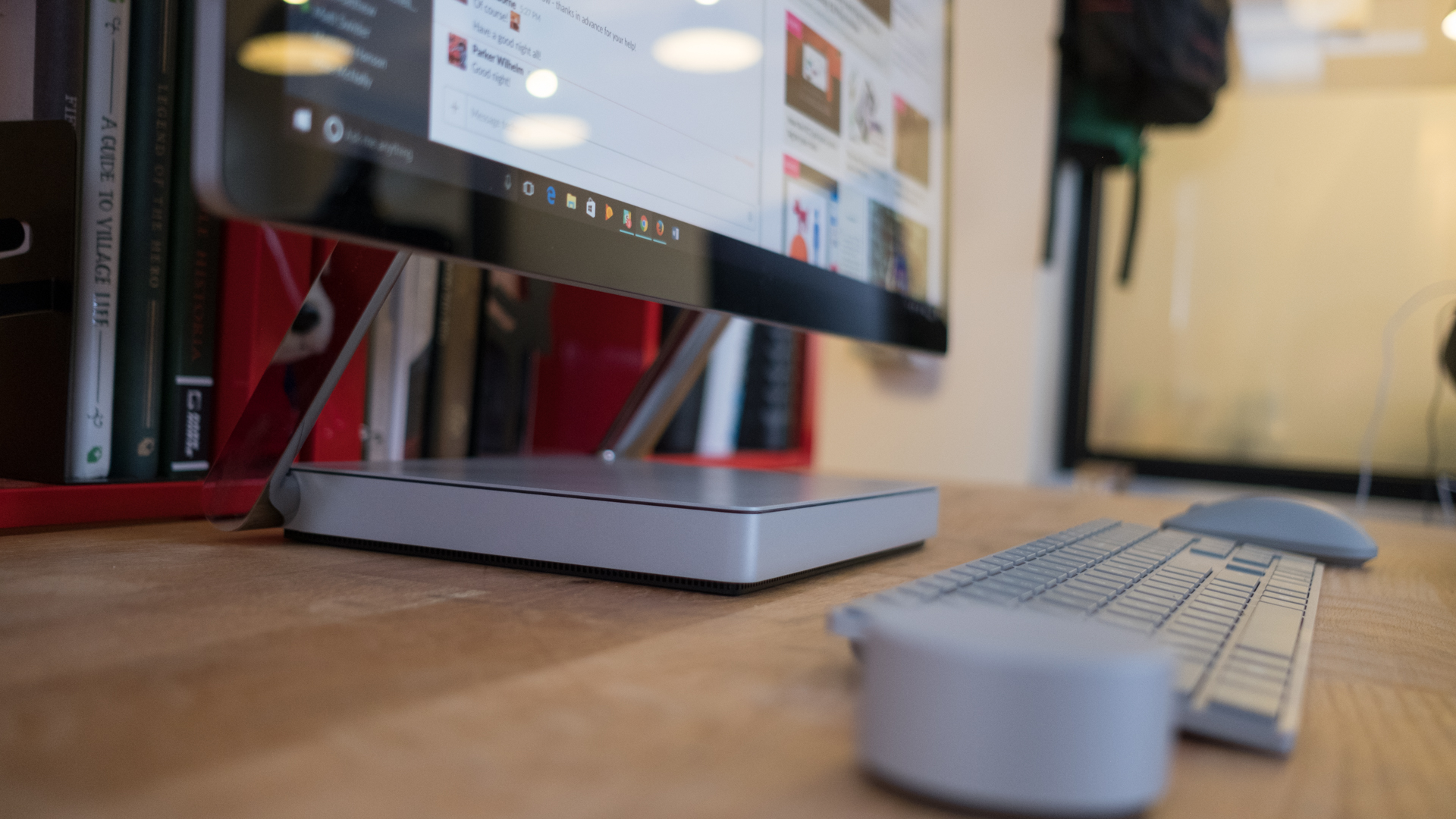
Microsoft arguably takes this clean aesthetic a bit too far, as all the USB 3.0 ports and the memory card reader are located on the rear. The lack of USB-C and ThunderBolt also means you won’t be able to take advantage of the fastest external drives.
Although we’ve already said our piece about the Surface Keyboard and Surface Mouse separately, it’s still worth mentioning here that we absolutely adore the completely wireless and clutter-free setup when paired with the Surface Studio, rounding out that minimalist look quite impeccably.
The two come included along with a Surface Pen in the box, though you might soon find that it’s not the best version of the accessory you can buy. With Microsoft having patented a new rendition of the Surface Pen, complete with haptic feedback capabilities, the experience of using the stylus accessory might resonate even more with us in the future.
Back to the digital drawing board
We’ve seen some truly stunning displays, such as the 5K iMac and Dell’s ridiculous 8K monitor. The Surface Studio, however, still takes the cake.
4,500 x 3,000 isn’t the sharpest resolution out there, but it’s sharper than a 4K display without going overboard. This combination of screen resolution and size with the Surface Studio’s unique 3:2 aspect ratio means you can snap four separate programs to each corner for multi-tasking and still have a legible view of all the apps. Frankly, the size and resolution just work.
Microsoft’s nearly perfect grasp of contrast and color gamut carry over the latest PixelSense display on the Surface Studio. Plus, there are more color profiles to choose from this time, including Vivid, DCI-P3 and sRGB to make it a truly production-grade display.
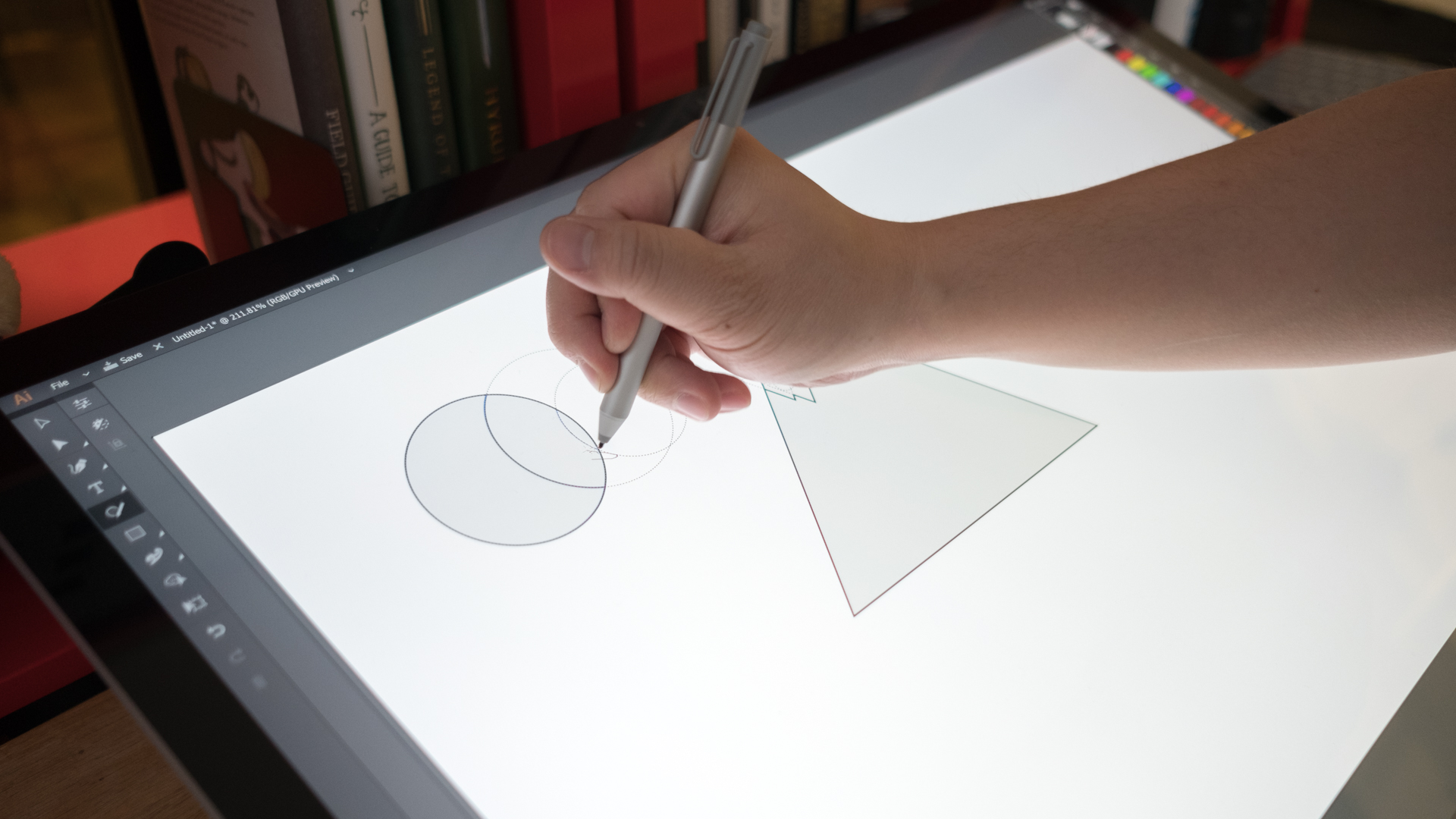
Holding up this stunning display is the Surface Studio’s other marquee feature, the Zero Gravity Hinge. This catchy-monikered mechanism absorbs all the torque required to move the 13-pound display, making it effortless to switch from a standard all-in-one PC to a digital drawing surface.
When lowered, the touchscreen on the Surface Studio holds itself at the same angle of pitch as a standard drafting table. Of course, you can also make adjustments at different levels of tilt, without having to worry about it moving under the weight of your hands while you work.
Drawing and writing feels almost too good to be true – just like the Surface Book and Surface Pro 4. The Surface Pen strokes translate flawlessly into lines of digital ink. While other styluses feel like they’re gliding on glass or cutting themselves into the touchscreen, Microsoft has found a way to offer just the right amount of resistance in its hardware.
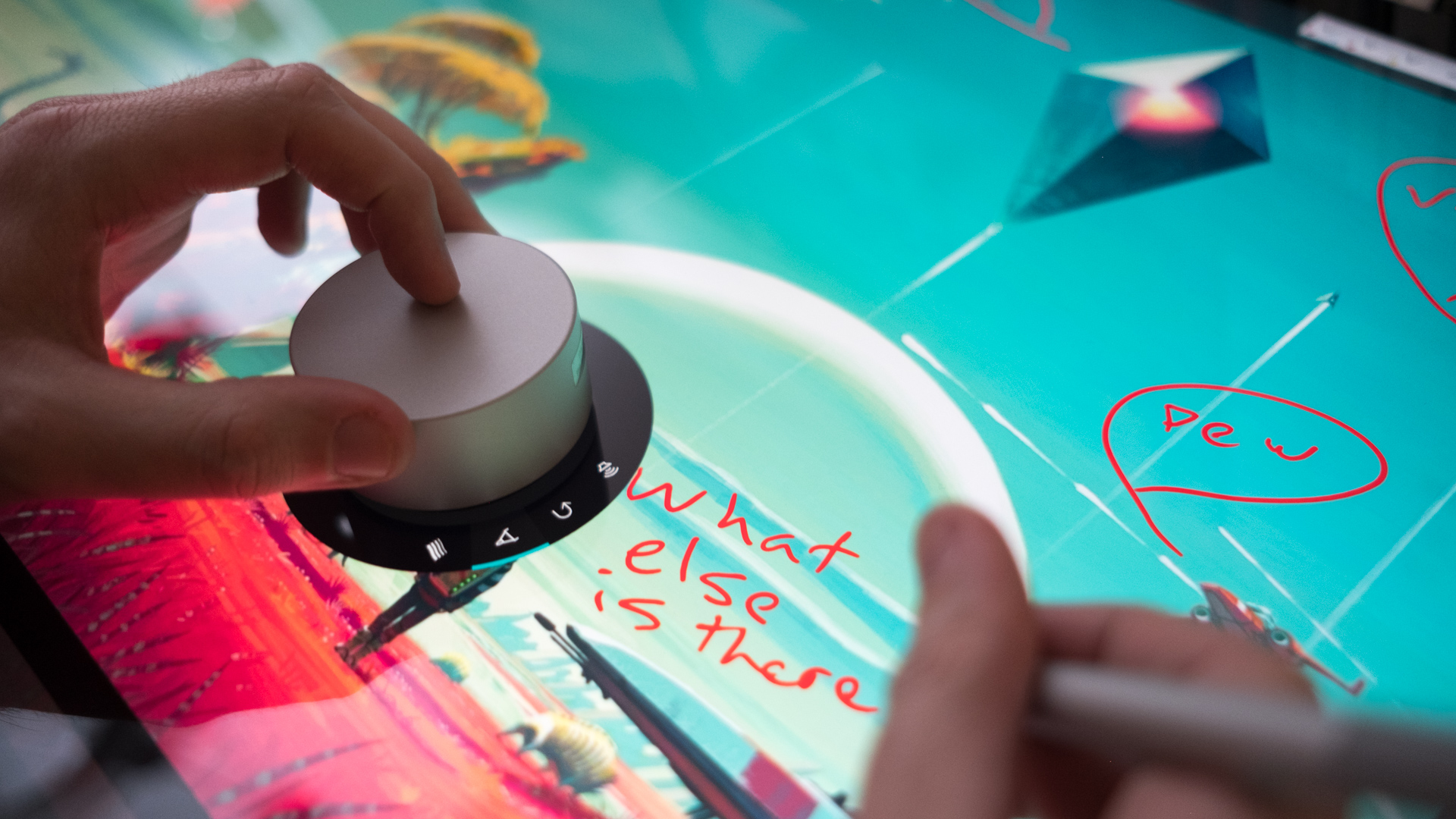
Dialing it in
Using Bluetooth to wirelessly tether it to the Surface Studio, the Surface Dial is a creation unique to Microsoft. Shaped much like a hockey puck, the Surface Dial has the potential to be a game-changer for creative professionals who prefer using Windows 10, a common demographic for the Redmond tech giant’s recent products.
The Surface Dial is intuitive. Within minutes of picking it up, you’ll realize it both spins as a dial and acts as a physical button. Pushing in the dial will bring up a radial menu of options like volume and screen brightness controls as well as zooming and scrolling. Push it again, and you can tweak whatever option you select.
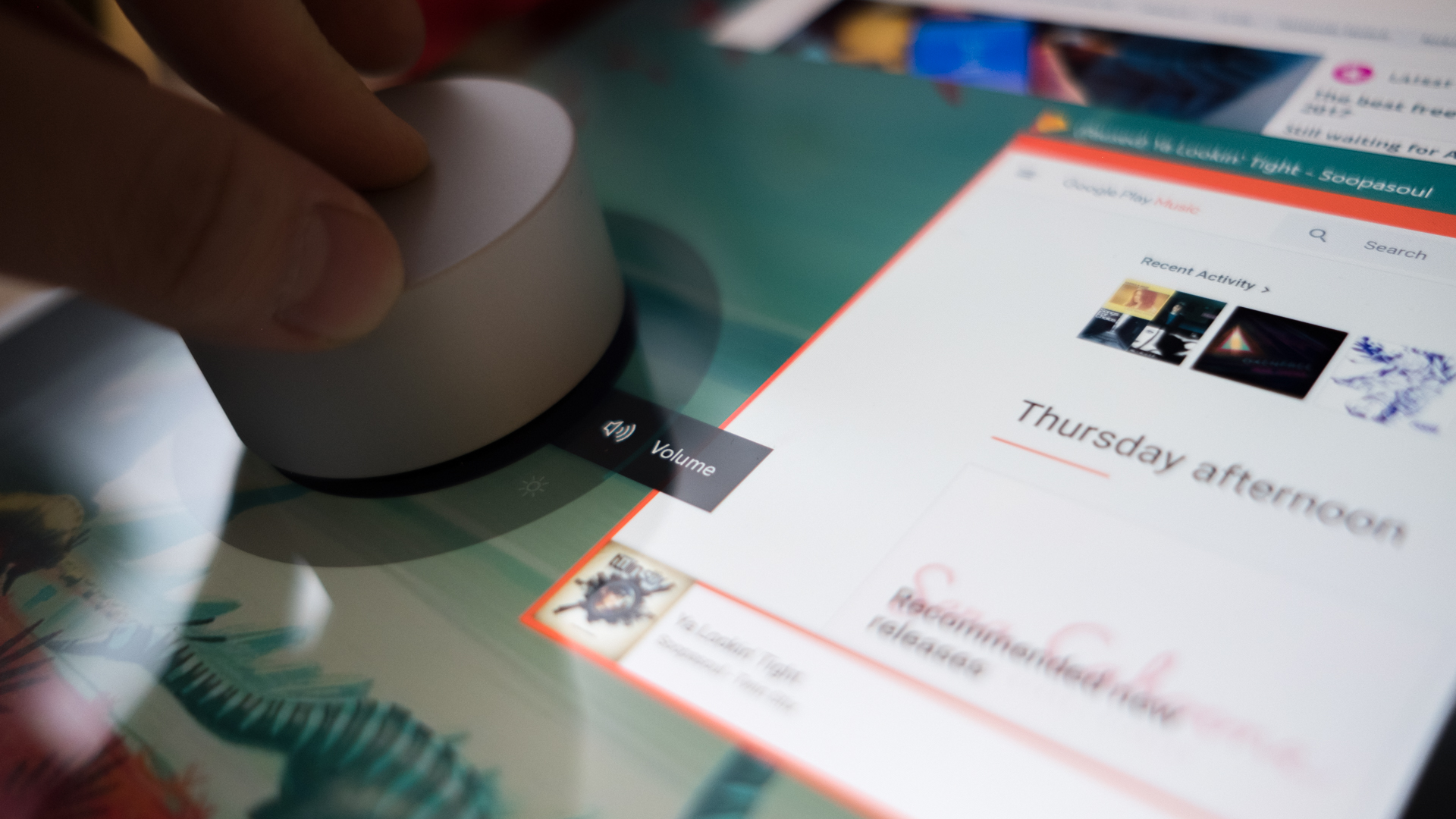
But that’s not all this nifty dial can do. The Surface Dial is also compatible with a wide array of apps that have been optimized in its favor. These include both first- and third-party applications, such as Adobe Photoshop and Illustrator, Microsoft Photos and even Spotify.
In the Adobe Creative Cloud software specifically, users can leverage the power of the Surface Dial to change brush settings as well as adjust size, opacity, hardness, flow and smoothing. In Spotify, on the other hand, the music volume can be changed by the force of a simple hand motion.
It might sound functionally simple, but having that quick — not to mention, easy — access to physical controls without having to stop drawing is huge in keeping your creative process seamless and distraction-free. And, if that still isn’t enough, after installing the Creators Update, you’ll get a bit more functionality out of the Surface Dial. The more recent versions of Windows 10 integrate customizable Dial controls and Paint3D as another app for the artistically adept.
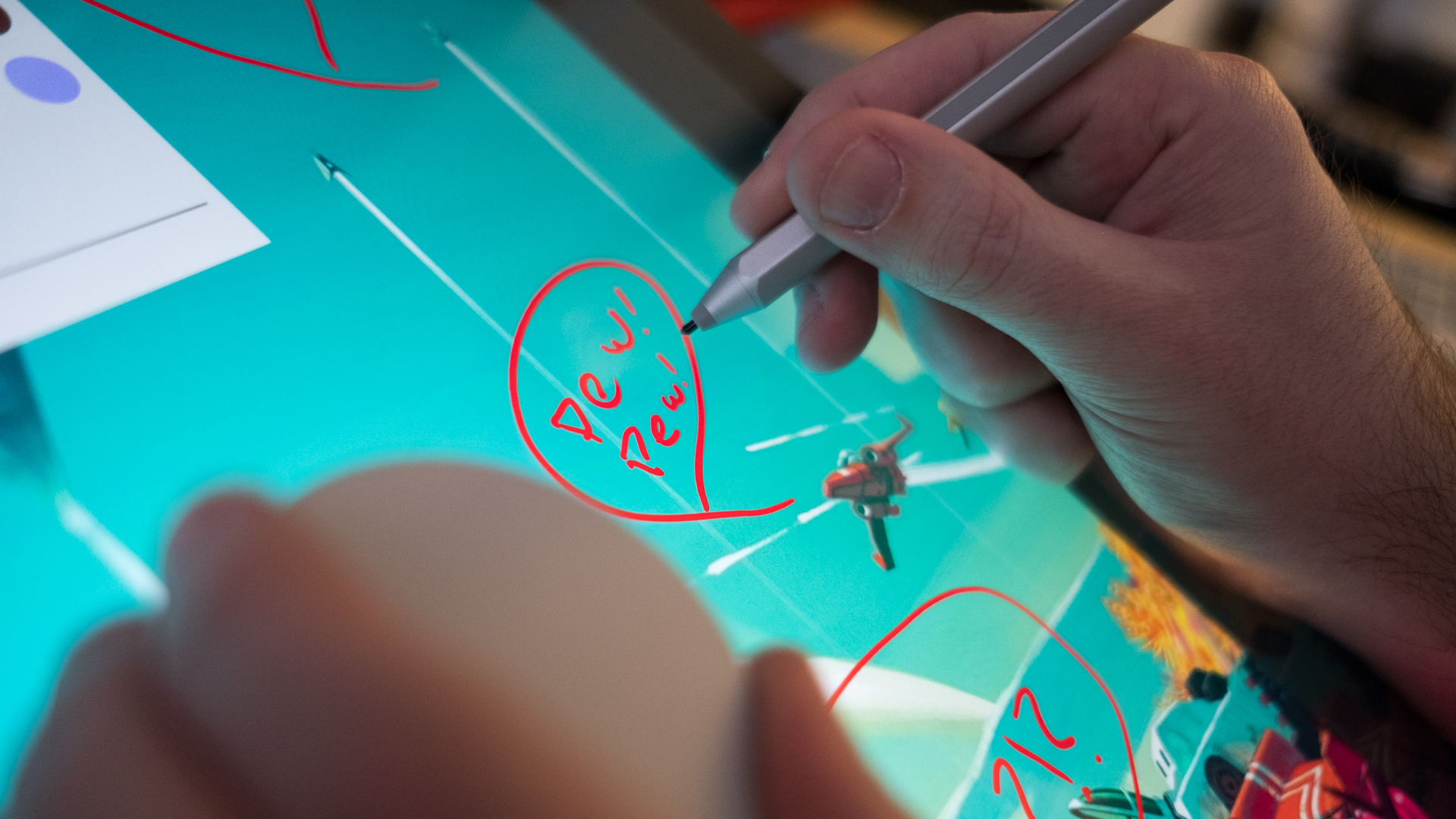
Of course, this also means only digital artists and other creative professionals are going to get the most out of this accessory. Plus, there is one small gripe we have with the Surface Dial: it doesn’t stay in place when you have it on the Studio’s screen. Instead, it slowly slides down the touchscreen – even if it’s lowered all the way.
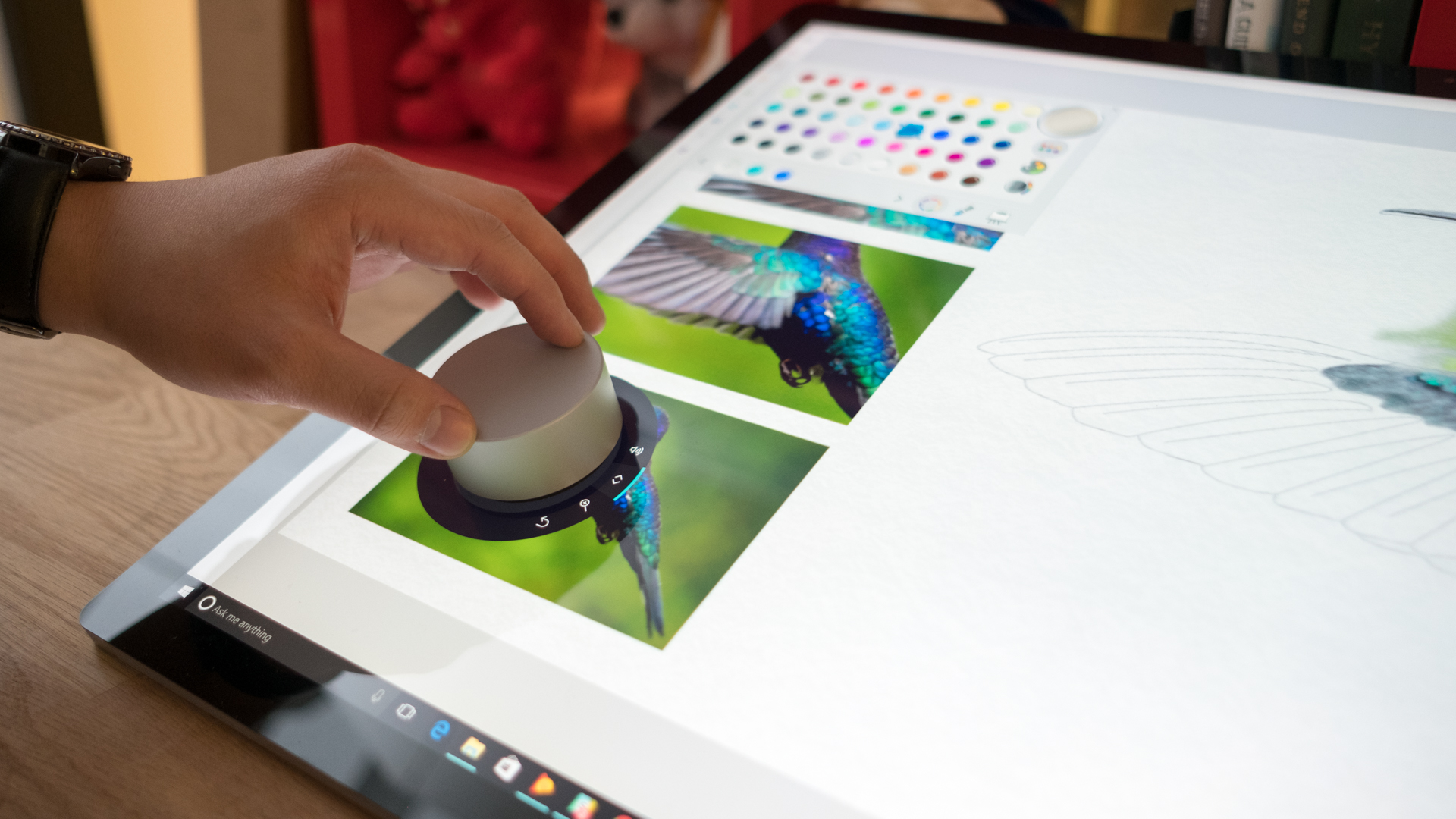
Here’s how the Microsoft Surface Studio performed in our suite of benchmark tests:
3DMark: Sky Diver: 21,345; Fire Strike: 8,103; Time Spy: 2,986
Cinebench CPU: 604 points; Graphics: 104 fps
GeekBench: 3,443 (single-core); 13,308 (multi-core)
PCMark 8 (Home Test): 3,234 points
The Division: (1080p, Ultra): 56 fps; (1080p, Low): 106 fps
GTA V: (1080p, Ultra): 32 fps; (1080p, Low): 162 fps
Performance
You might balk at the graphics chip from last year and the less-than-current Skylake processor on its spec sheet, but the Surface Studio keeps up with other all-in-one machines.
Armed with high-end graphics chip, the Surface Studio is well ahead of the XPS 27 AIO and iMac with 5K Retina screen with a Fire Strike score that’s almost four times higher. Unfortunately, the Surface Studio’s processing power doesn’t prove to be as impressive, and its more CPU-intensive benchmarks scores fall behind.
Benchmarks aside, this desktop knows how to put in work. Microsoft’s AIO never buckled, even as we opened dozens of tabs on two web browsers, a separate Google Music streaming app, Slack, Adobe Photoshop and Illustrator all at once. Even Lightroom, which usually grinds gaming laptops to a halt, ran smoothly on the Studio as we did a bunch of post-processing work during our review.
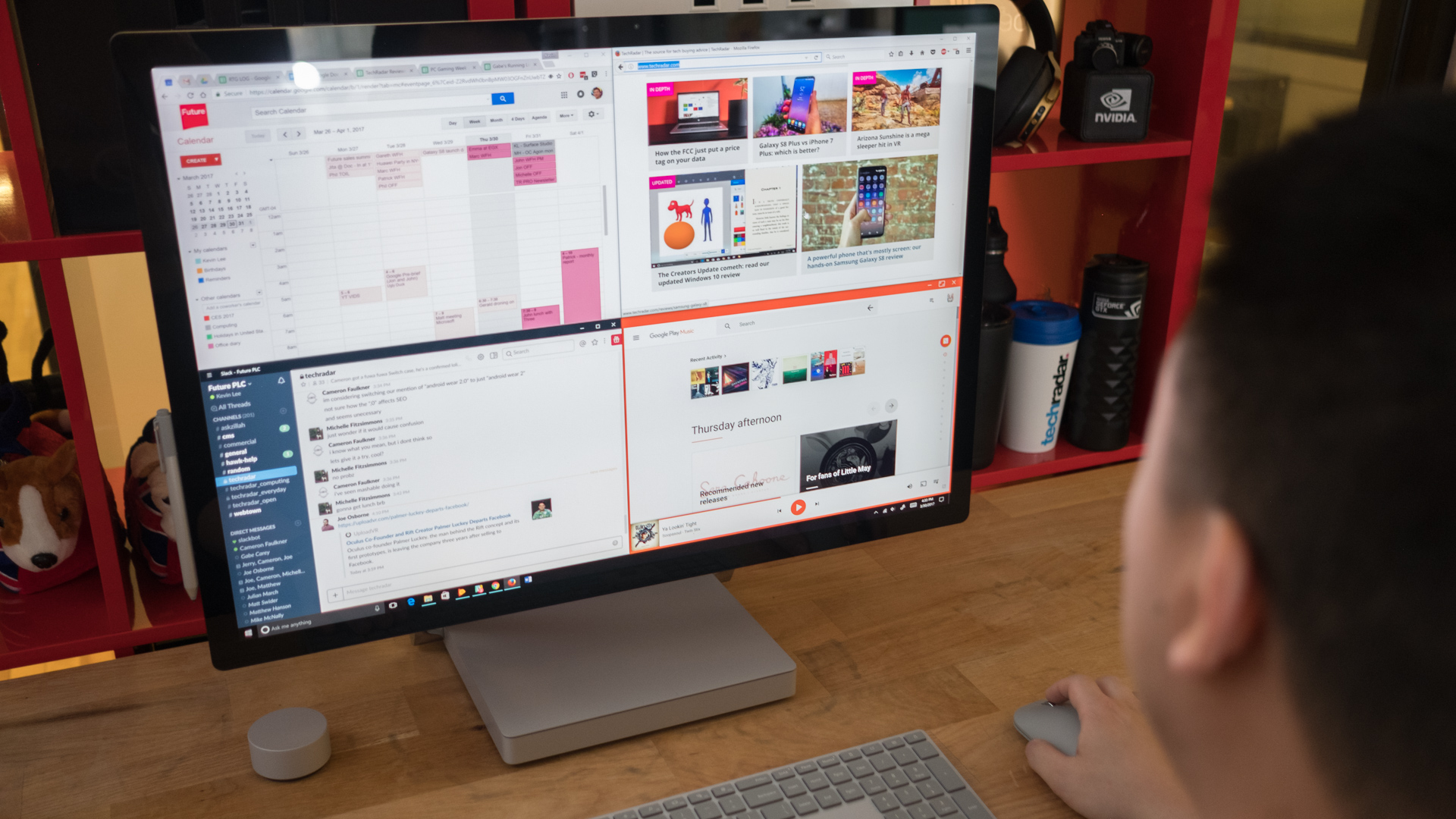
We also played a fair number of Overwatch matches at full-screen resolution on Ultra settings without issue. During our entire time with the device, we didn't encounter any graphical performance issues that would have required the latest Nvidia graphics.
The most admirable thing about the Surface Studio’s performance is how quickly everything loads on it. Rather than being equipped with a traditional SSD or hard drive, Microsoft used Intel’s Rapid Storage Technology to intrinsically tie a 2TB spinning drive to 128GB of flash memory.
In this setup, the hard drive does all the heavy lifting when storing all your files, while a smaller segment of your data is compartmentalized onto the SSD if it has been associated with a commonly used program or service. Although this system doesn’t allow you to directly access this faster storage solution, we never felt like we had to as files loaded seamlessly and quickly the whole time.
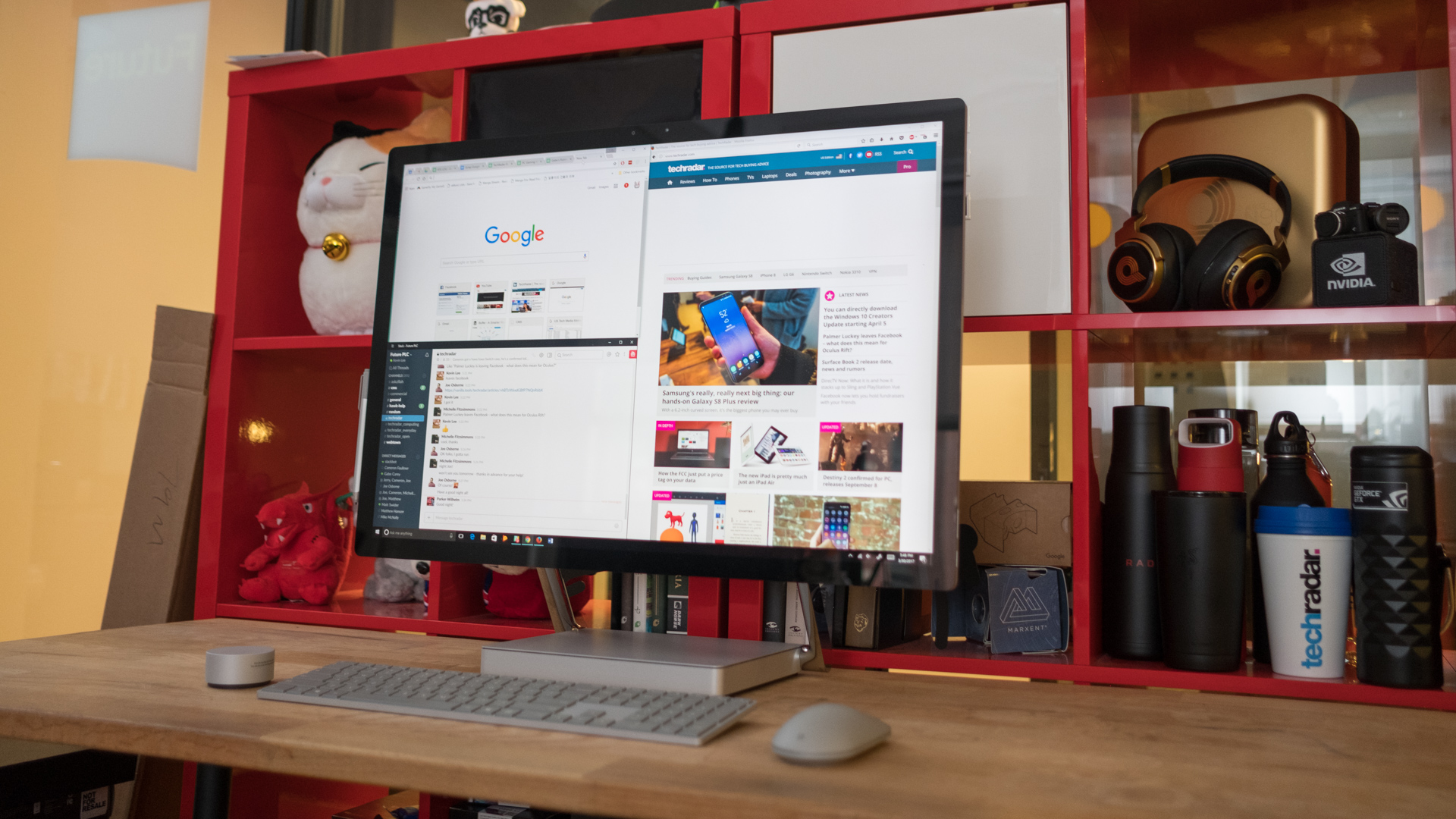
Final verdict
If you weren’t interested in the Surface Studio already, our review probably wouldn’t change your mind. That’s mostly because Microsoft’s contribution to the all-in-one PC sphere is expensive to say the least. But, this computer is also nothing short of the best when it comes down to build quality and innovation beyond offering the latest specs.
Whereas the iMac, Dell XPS 27 AIO and HP Envy 27 AIO are all compelling alternatives for different reasons, the Surface Studio thrives because of its uncompromising desire to be something else entirely. For the price of a Surface Studio, sure, you could build a PC that’s a lot more powerful, and you’ll probably still have money left over.
However, if you’re an artist and especially an illustrator, the Surface Studio introduces a new wrinkle into a world primarily dominated by Wacom tablets. The Surface Studio not only allows you to sketch and inspect your picture with one device, but the visual quality of the PixelSense display is also far better than that of Wacom’s Cintiq display or Dell’s new 27-inch Canvas.
For these reasons, we’ll say it again – the Surface Studio best serves artists and illustrators. It’s, without a doubt, one of the best computers ever designed.
However, there’s no reason for regular users to purchase this. Well, unless they’re in the market for the highest end iMac and want more features – or they want bragging rights.
Bill Thomas and Gabe Carey have also contributed to this review
First reviewed April 2017
Image Credit: TechRadar
- Get the best deal on you next Microsoft product with our Microsoft coupon codes.
Kevin Lee was a former computing reporter at TechRadar. Kevin is now the SEO Updates Editor at IGN based in New York. He handles all of the best of tech buying guides while also dipping his hand in the entertainment and games evergreen content. Kevin has over eight years of experience in the tech and games publications with previous bylines at Polygon, PC World, and more. Outside of work, Kevin is major movie buff of cult and bad films. He also regularly plays flight & space sim and racing games. IRL he's a fan of archery, axe throwing, and board games.
